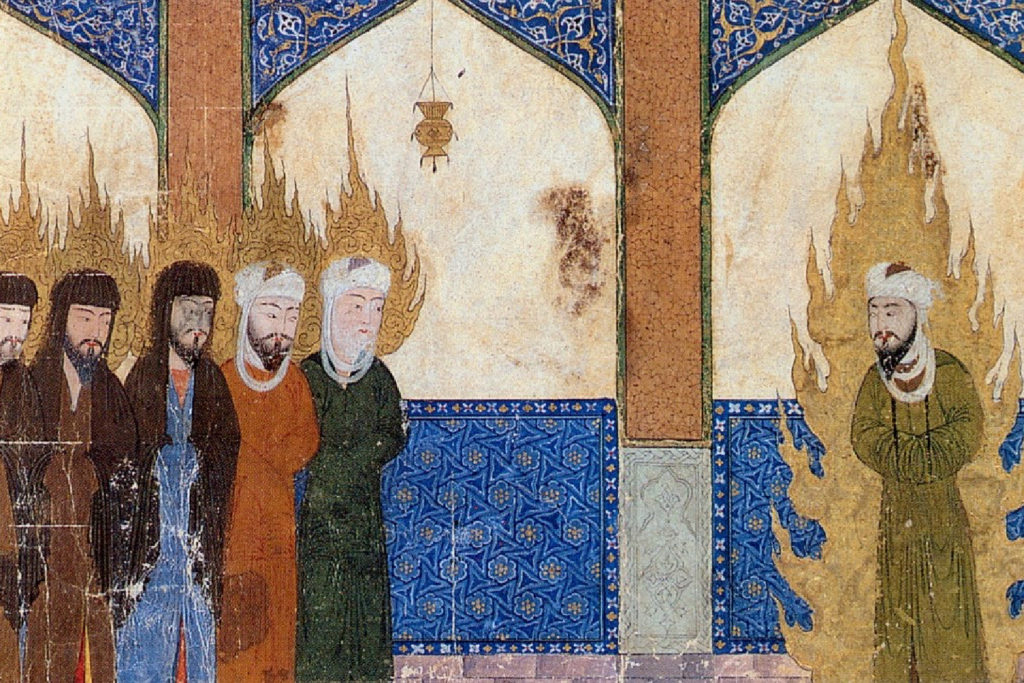By David Wood
With a superb script, unparalleled directing, and flawless acting, Sergio Leone’s The Good, the Bad, and the Ugly is the greatest “spaghetti western” of all time. I have only one problem with the film. While I understand why the sociopathic mercenary Angel Eyes is called “the Bad,” and why the underhanded bandit Tuco is called “the Ugly,” I’ve never been able to figure out why the bounty hunter Blondie is called “the Good.” In the film, Blondie’s money-making scheme is to capture criminals, turn them in to collect the reward, free them before they are executed, and split the money with them. He then turns the criminals in at the next town, collects the reward, and so on. When a criminal’s bounty is no longer increasing, Blondie takes him deep into the desert to die of heat exhaustion. Why, then, is he good? The only answer I’ve ever been able to come up with is this: Blondie is played by Clint Eastwood, so he must be good—regardless of what he does.
We find a similarly puzzling bit of reasoning when we turn to Islam. Muslims confidently proclaim that Muhammad was history’s greatest moral example, a man whom all people would do well to emulate (see Qur’an 33:21). What happens, then, when we turn to history and meet a shockingly different figure? The unstated Muslim response seems to be: “Muhammad was God’s greatest prophet, so he must be good—regardless of what he did.”
In this article, we will examine the life of the Historical Muhammad, that is, the Muhammad we learn about through careful historical investigation, rather than the Muhammad of faith. As we shall see, there is a massive difference between the two.
I. SOURCES
Before we discuss Muhammad’ history, a brief analysis of sources is in order. While the primary source of Islamic doctrine is the Qur’an, the Qur’an is not biographical in nature, and it tells us practically nothing about Muhammad. To learn about Muhammad, we must turn to other sources—the Hadith and the Sira literature.
The Hadith are collections of sayings and deeds of Muhammad, usually arranged topically. The goal of the writers was to describe what Muslims should do in a given situation, based on the example set by their prophet. The Sira literature was quite different. Sira writers often attempted to write complete accounts of the life of Muhammad, and these writings are therefore quite similar to modern biographies. The two genres of historical writing employed slightly different methodologies, and Muslims today favor Hadith over Sira.
Here we encounter a significant problem for our historical investigation. The primary Hadith collections were written more than two centuries after Muhammad’s death, and even the earliest extant Sira work (Ibn Ishaq’s Sirat Rasul Allah) comes from more than a century after the life of Muhammad (and Muslims themselves typically reject this source). We therefore have no detailed historical source written within a century of the prophet of Islam, and no source trusted by the majority of Muslims within two centuries. Such a time gap calls much of Muhammad’s life into question, and some scholars hold that we can know virtually nothing about him (or even that he existed). In this study, we won’t be quite this skeptical. What follows is a survey of some of the major events that can reasonably be ascribed to the life of Muhammad.
II. A BRIEF HISTORY OF MUHAMMAD
A. Prior to the Call
Muhammad was born in Mecca around 570 AD. His father died before he was born, and his mother died when he was about six years old. We don’t know much about Muhammad prior to the time he started receiving his revelations. Muslim tradition tells us that he was known as al-ameen, “the trustworthy,” so he may have had a reputation for honesty in his dealings with others. Apparently, he was handsome as well. One day a rich widow named Khadija (Muhammad’s employer) asked him to marry her, and Muhammad accepted. Khadija was around fifteen years older than Muhammad, who was twenty-five at the time, but by all accounts, it was a happy marriage.
B. The Meccan Period
In the year 610, Muhammad was in a cave on a religious retreat, and something interesting happened.
When it was the night on which God honoured him with his mission and showed mercy on His servants thereby, Gabriel brought him the command of God. “He came to me,” said the apostle of God, “while I was asleep, with a coverlet of brocade whereon was some writing, and said, ‘Read!’ I said, ‘What shall I read?’ He pressed me with it so tightly that I thought it was death; then he let me go and said, ‘Read!’ I said, ‘What shall I read?’ He pressed me with it again so that I thought it was death; then he let me go and said ‘Read!’ I said, ‘What shall I read?’ He pressed me with it the third time so that I thought it was death and said ‘Read!’ I said, ‘What then shall I read?’—and this I said only to deliver myself from him, lest he should do the same to me again. He said:
‘Read in the name of thy Lord who created,
Who created man of blood coagulated.
Read! Thy Lord is the most beneficent,
Who taught by the pen,
Taught that which they knew not unto men.’
So I read it, and he departed from me. And I awoke from my sleep, and it was as though these words were written on my heart.”i
Muhammad was terrified by what happened to him. He believed that he had encountered a demon, and he became suicidal. His wife Khadija and her cousin Waraqah, however, convinced him that he was a prophet of God, and that he had met the angel Gabriel in the cave.
Muhammad spent the next twelve years preaching in Mecca, first only in private, then in public. During these early years, Muhammad preached a peaceful message. He called for religious tolerance,ii but he told people that they needed to turn to Allah. In general, the polytheistic Meccans hated him. The persecution eventually got so bad that Muhammad accepted an invitation to move to another city.
C. The Medinan Period
In 622, Muhammad and most of his followers moved nearly 300 miles north to what is now Medina. It’s difficult to overestimate the importance of the move of the Muslims from Mecca to Medina. It was in Medina that the Muslim community became a political entity, which is central to Islam.
From his base in Medina, Muhammad began a series of raids against the Meccan caravans. While the first six raids failed, the seventh raid—the “Nakhla raid”—was a success. The problem was that the Muslims attacked during a holy month in which everyone had agreed not to fight. An innocent man was even killed during the raid. This eventually led to war between the Muslims and Mecca.
Understandably, the people of Mecca sent around 1000 guards to protect their next caravan. The Muslims attacked with a much smaller force, and they won what came to be known as the Battle of Badr. For the next ten years until Muhammad’s death in 632 AD, the Muslims never stopped fighting. Muhammad fought several more key battles against Mecca (the Battle of Uhud and the Battle of the Trench), finally taking the city in 630.
Muhammad attacked other groups as well. In 629, Muslims attacked a Jewish settlement in the oasis of Khaybar in Northwestern Arabia. Shortly after the conquest of Mecca, Muhammad received Surah 9:29, which ordered Muslims to fight non-Muslims (including Christians and Jews) until they submit to Islam:
Fight those who do not believe in Allah, nor in the latter day, nor do they prohibit what Allah and His Apostle have prohibited, nor follow the religion of truth, out of those who have been given the Book, until they pay the tax in acknowledgment of superiority and they are in a state of subjection.iii
Obeying this command to fight, Muhammad marched an army against the Byzantine Empire, though the Byzantines chose not to fight. Muhammad became sick and died shortly thereafter.
III. MUHAMMAD: THE GOOD
Now that we have an outline of Muhammad’s life, it might be helpful to zoom in on some specific issues to help us form an accurate picture of the prophet of Islam. While it is an error to maintain, as Muslims do, that Muhammad was history’s greatest moral example, some critics are equally mistaken when they go to the opposite extreme and portray Muhammad as history’s worst moral example. Indeed, Muhammad had many positive characteristics. We know that he was courageous, both because he patiently endured several years of persecution in Mecca and because he fought in numerous raids and battles. Throughout his life, Muhammad placed an emphasis on helping orphans and widows. There were times when he showed great mercy. He was an ardent monotheist, and despised idolatry. He told his followers to heed God’s prophets, such as Noah, Abraham, Moses, and David. These are areas where even non-Muslims would agree that Muhammad exhibited positive traits.
IV. MUHAMMAD: THE BAD
Yet Muslims tend to focus solely on the good characteristics of their prophet, and to completely ignore less admirable qualities. We have already seen that Muhammad began robbing caravans after leaving Mecca. As a result,greed soon became one of the primary factors in people’s rapid conversion to Islam. Indeed, Muhammad deliberately used the spoils of war to lure people to Islam. When he was criticized for the way he distributed his newfound wealth, he replied, “Are you disturbed in mind because of the good things of this life by which I win over a people that they may become Muslims while I entrust you to your Islam?”iv
Although Muhammad patiently endured persecution in Mecca, his attitude quickly changed when his numbers grew in Medina. Soon he would tolerate no criticism whatsoever. According to our earliest biographical source, a man named Abu Afak—who was more than a hundred years old—wrote a poem criticizing people for converting to Islam. Muhammad demanded he be killed, and Abu Afak was murdered in his sleep. When a woman named Asma heard that Muslims had killed such an elderly man, she wrote a poem calling for people to take a stand against Islam.Ibn Ishaq relates what happened next:
When the apostle heard what she had said he said, “Who will rid me of Marwan’s daughter?” Umayr bin Adiy al-Khatmi who was with him heard him, and that very night he went to her house and killed her. In the morning he came to the apostle and told him what he had done and he said, “You have helped God and His apostle, O Umayr!” When he asked if he would have to bear any evil consequences the apostle said, “Two goats won’t butt their heads about her,” so Umayr went back to his people.v
Muhammad’s violence was directed towards groups as well. Muhammad once said to his followers, “I will expel the Jews and Christians from the Arabian Peninsula and will not leave any but Muslims.”viThe Jews of Qurayza resisted Muhammad and attempted to form an alliance against him. When the alliance faltered, Muhammad acted quickly. His armies surrounded them and “besieged them for twenty-five nights until they were sore pressed and God cast terror into their hearts.”
Then they surrendered, and the apostle confined them in Medina. . . . Then the apostle went out to the market of Medina (which is still its market today) and dug trenches in it. Then he sent for them and struck off their heads in those trenches as they were brought out to him in batches. . . . There were 600 or 700 in all, though some put the figure as high as 800 or 900.vii
Every male who had reached puberty was killed. Muhammad divided the women, children, and property among his men (taking a fifth of the spoils for himself).
V. MUHAMMAD: THE UGLY
But things get worse. As the Muslim armies raided town after town, they captured many women, who would often be sold or traded. Yet, since the Muslim men were a long way from their wives, they needed wisdom from Allah to guide them in their treatment of their female captives. It wasn’t long before Muhammad received a revelation allowing the soldiers to sleep with the women:
Allah’s Messenger sent an army to Autas and encountered the enemy and fought with them. Having overcome them and taken them captives, the Companions of Allah’s Messenger seemed to refrain from having intercourse with captive women because of their husbands being polytheists. Then Allah, Most High, sent down regarding that: “And women already married, except those whom your right hands possess (iv. 24)” (i.e. they were lawful for them when their ‘Idda period came to an end).viii
This verse of the Qur’an (4:24), along with others (23:1-6; 33:50; 70:22-30), granted Muslims the right to have sex with their female captives and slave girls, even those who were still married or who were going to be sold or traded.
Perhaps most disturbing of all is the fact that Muslims could have sex with girls who hadn’t even reached puberty. The opening verses of Chapter 65 of the Qur’an present Islamic rules for divorce. According to 65:4, if a Muslim divorces a girl who hasn’t yet reached puberty, he must wait three months to make sure she isn’t pregnant.
Muhammad himself had sex with a prepubescent girl. His courtship of Aisha began when she was only six years old.ix Muhammad had a dream about her, which led him to believe that God wanted him to marry the young girl.x Fortunately, Muhammad waited three years before having sex with her; nevertheless, Muslim sources report that Aisha still hadn’t reached puberty.xi Since Muhammad is the moral exemplar in Islam, his actions are still affecting young girls today.
VI. ASSESSMENT
At the end of The Good, the Bad, and the Ugly, Blondie famously says, “You see, in this world there’s two kinds of people, my friend—those with loaded guns, and those who dig. You dig.” Similarly, we may say that there are two types of beliefs in this world—those that are based on evidence, and those that aren’t. Muslims believe that Muhammad was morally perfect, and that an examination of his life will prove that he was a prophet. The evidence, however, shows that Muhammad was far from morally perfect, and that there’s no good reason to believe that he was sent by God. There is a world of difference, then, between the Muhammad of history and the Muhammad of faith.
We may contrast this with the historical Jesus. Christians believe that Jesus was a miracle worker, who claimed to be divine, died on the cross, and rose from the dead. A careful historical investigation confirms all of these beliefs. Thus, while Christians have absolutely nothing to fear from an examination of early historical sources, history is a huge problem for Islam.
iIbn Ishaq, Sirat Rasul Allah (The Life of Muhammad), A. Guillaume, tr. (New York: Oxford University Press, 1980), p. 106.
ii See, e.g., Qur’an 109.
iii M. H. Shakir Translation.
iv Ibn Ishaq, p. 596.
v Ibid., p. 676.
vi Sahih Muslim 4366.
vii Ibn Ishaq, p. 464.
viii Sahih Muslim 3432.
ix Sahih Al-Bukhari 3894.
x Ibid., Number 3895.
xi See Sahih al-Bukhari 5236 and 6130.
Published March 30, 2016




